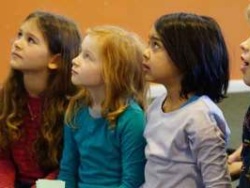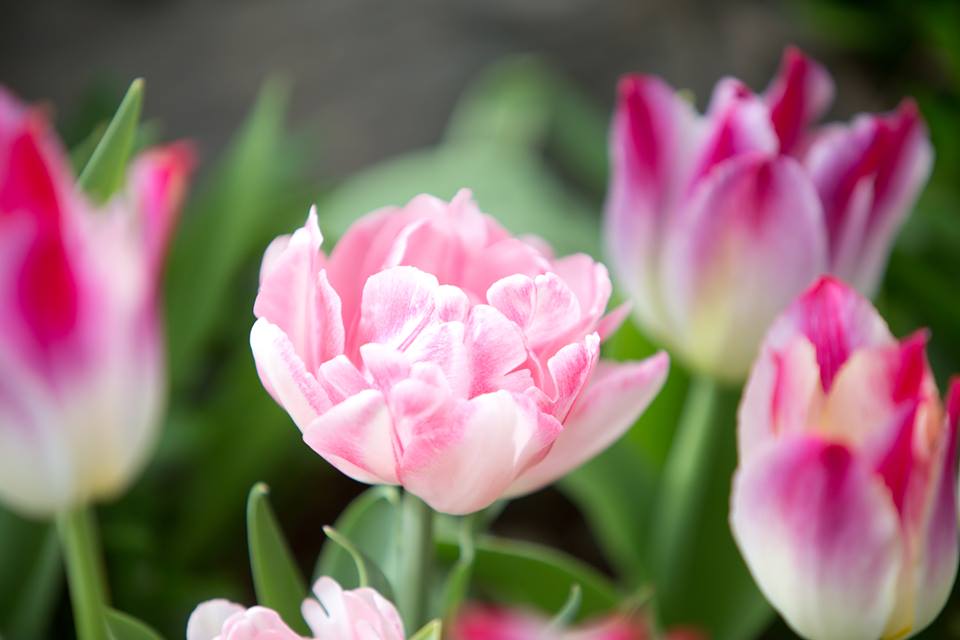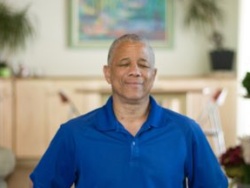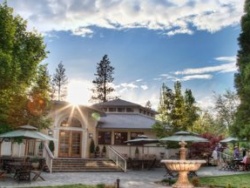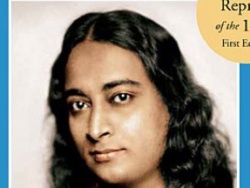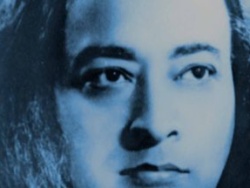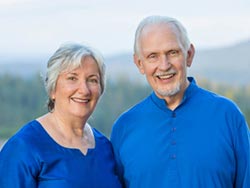My early introductions to this path were memorable; my family lived in Manhattan Beach in southern California and we’d often take the old Highway 1 down to San Diego to visit my grandparents. We would pass by the Encinitas towers, which is where Yogananda had his seaside hermitage. The towers were so striking and unique that I would always ask my father what they were. My answers didn’t come until I got on the spiritual path. In reflecting back, I loved the symbolic thought of the guru coming in at an early age.
During my youth and teen years, the thing that helped me establish my spiritual life was my frequent visits to Mexico. I was struck by the devotion and simplicity of the Mexican people. Being raised in a home where there was no television, I was a bit of a curiosity in my own southern California neighborhood. We did other things for entertainment: Sunday drives and symphonies, plays and special events. Since I wasn’t constantly being saturated by media, I had acquired a taste for simplicity—a quality that my parents emanated and for which I’ll always be grateful.
My first very powerful spiritual experience came during a High Mass I attended one Christmas in Guadalajara, Mexico. It was the power of love and the simplicity of the people there that moved me so deeply. I had to tell myself that someday I wanted to come back to the feeling I had there. It was a very heart-opening experience. Being raised half-Catholic, half-Jew, I could have had my Bar Mitzvah at 13 if I wanted to, but I didn’t think it was fitting because all my friends were going after the toys which you’d get in superabundance at that event. So, I decided it would be a sacrilege. I had too much respect for the mystical side of Judaism.
During my last year of high school I became interested in Yogananda’s teachings. A friend that I was close with gave me a book, The Master Said, which is now called Sayings of Yogananda. I opened the page, saw Yogananda’s photo, and read, “If you want to find God, yearn for Him like a drowning man yearns for air.” That little saying took me right onto the path. I wanted to be a monk. But I was a bit taken aback, because I still had my band of friends, and we were having lots of fun. This was during the late sixties and I was going to Griffith Park with friends who were into alcohol and drugs. I had to process my desire to be a monk, and I did, usually under the influence. I knew if I gave up alcohol and drugs I would lose a batch of friends, and I knew it was going to be a very lonely journey. But what on earth was I going to do with my life? Be a rock star? Open a large, non-profit veterinary complex with my girlfriend? I thought of all the things that we think about when we’re free of responsibility and yet can dream. As I dropped out of the social scene more and more, my friends started to wonder if I’d gone a bit overboard.
Finally, I decided I didn’t want to mix Yogananda’s teachings with drugs and alcohol. So, for discipline, I also embraced a Buddhist path for two years. Basically, what you did on that path was to chant for things in order to get the things you wanted and to be able to put material desires aside. I chanted for all the things I wanted, and it worked. And the last thing I chanted for was that I would be free of the things that were encumbering me: the alcohol and drugs—not that I was addicted, but they were hanging on. I wanted to be free of them so that I could concentrate on Yogananda’s path exclusively. And it worked like magic.
After this, I saved up money from working in a gas station and began a journey to Vermont, where I had this dream I would spend the winter determining whether to be a monk in Self-Realization Fellowship, or whatever. While I was hitchhiking across the country, I had a very interesting experience in Redding, California—a psychic picked me up. I had a real good feeling about his integrity. He explained things about the Bible that were of interest to me; being half-Catholic, half-Jew I was trying to figure that one out! So then I asked him about a place I’d just recently heard of called Ananda. And he said, “You’ll like it there. That’ll be your home.” And that was it.
The first night I came to Ananda Village there were all these joyous people greeting me. And I thought, “They have something I want.” Soon it became apparent that they had an inner joy I really hadn’t ever seen before. I had found it in a few individuals: a postman would have it, a grocery clerk or teacher—but it was very infrequent.
In 1970, it cost $30 to spend a month at Ananda on work-study. If you wanted to eat, it was an additional $15, for $45 total. I still have a little slip of paper from Satya when he first signed me in. I worked as Satya’s sidekick, painting beds and helping out with the retreat. When I first came, all the tents were reserved, so for three weeks I slept on top of a picnic table out by Kali Lodge near the fire pit. I worked a lot in the kitchen, and in the late evening some of us would sneak into the kitchen and eat cashews like raccoons. Shradda Ma was the cook in charge, and we were afraid of her because she was so tough. But we loved her dearly. And we were always keen on helping her out to make amends for our evening’s jaunt into the cashews and dates.
I had met Swami Kriyananda that first night I arrived, and he was a young man, in his early forties. Right away I had a deep appreciation of who he was and a glimpse of what he had attained on a spiritual level. To be with a direct disciple of a great master was a dream come true. But it didn’t mean that it would be easy. In Swami, I saw a man of extraordinary energy. Just being in his presence challenged us to wake-up and begin the race to God-realization.
After I had been at Ananda for about a year, my first big opportunity to grow appeared. Swami asked if I would build something to house our cottage industries. I couldn’t believe he’d ask me. I was just barely out of my teens and my construction expertise was sorely lacking. Nevertheless, I tried. My first day on the job found me sitting on a tree stump, completely overwhelmed and paralyzed with fear. As it worked out, a friend, who was about 17, took the project over and the building went up, much to my astonishment. Though greatly relieved, I knew my work was cut out for me. I would have to tackle my fears while following Swami, our fearless leader! I have always appreciated his “go for it” spirit of adventure, especially when I have seen him tackle projects which I consider beyond the scope of what most people can do. I’ve learned a lot by watching him come through many different experiences with grace, regardless of a project’s success or failure.
After being at Ananda for some time, I began to pray for some way that I could earn my membership money. The answer to my prayers came in the form of a little jewelry shop Binay had opened, which was located where the bakery is now. This had been an old chicken coop, so I had to clean out the chicken manure and fix the place up before we could begin to produce flower jewelry. That was my first formal employment at Ananda. Prior to that it was three months of honeymoon; those three months stick in my mind to this day as a time of just pure joy. Even though Ananda was challenging on the physical plane, it was a very happy time.
In the fall of 1971, Swami founded the monastery and I was asked to join. I’ll never forget taking our first monastic vows at his Seclusion Retreat dome. The power of those few hours is with me still. The monastery grew rapidly, and we were all very committed to our spiritual life and the need to roll up our sleeves and help out with the various businesses.
The monks built platforms for teepees and mine was equipped with an outdoor refrigerator, so there were a few comforts of home. The main thing that I enjoyed about the monastery was the esprit de corps and the support of the monks. We had many group sadhanas, and one of the highlights was that Swami would have satsangs with the monks and nuns at his dome. He would read to us the transcripts of the different books he was writing; we would look forward to that immensely. It was a tremendous experience for us.
I remember a particular instance which was a lot of fun: I decided to take a peek at the monks and nuns while they were meditating with Swami, because I thought it would be interesting to see how people were doing. All of the monks looked like women; their spines were kind of bent over, and they looked sweet. And all the nuns looked like men; their spines were straight and they looked like they were going to burn up the universe! I nearly burst out laughing, because of the contrast. The monks were trying to balance their energies, because all of us have a strong will, classically the masculine will. We needed to develop the more receptive, intuitive, feminine aspects of ourselves. If they needed it, the nuns were working on developing more masculine aspects. Everyone is different; some people are more masculine, some people are more feminine. That image of the monks and nuns meditating never left me. And I see those same things here at Ananda today.
For the monks, it was very austere in the early days because we weren’t focused on building up the comforts of the monastery. We were focused on building the Village. We’d work on trying to renovate the chicken coop so we could get the jewelry shop in, or remodel the incense shop or build the publications building. Our foundation was all about meditation, in the morning and in the evening when we returned from work.
One time we rented what we called the “Monkmobile,” which was a nine-seater brand new stationwagon, and we all went down to the SRF Convocation. In the early years we all went with Swami, but he didn’t go into the Convocation. We’d spend time with him though, then we’d all roar off to Disneyland for a brief respite. I enjoyed Convocation immensely, except for the political aspects between SRF and Swami, which were very unpleasant. There was one time when a particular SRF monk came and spoke against Ananda in a disguised fashion, but so thinly disguised that the energy was very polarized against Ananda. As Ananda’s Spiritual Renewal Week grew and became a very strong force, the need to go to Convocation fell away.
After 12 years of living as a monk at Ananda, I left the monastery. A few years later I met my wife, Eilleen (who later received the spiritual name Roma), and the next exciting chapter began. It was time to embrace the life of a householder. The transition from monk to householder was an easy one for me in many respects. I saw before me vast opportunities to serve selflessly, coupled with increased joy! New people who come to Ananda and the spiritual path will see in a glance what the householders’ path is about. When you’ve got a kid tugging on you, there it is in front of everybody to see. Kids are great for that. They put out the message as no one does, in my opinion, because they let you know where you’re standing spiritually every moment.
Many of the kids here are very strong-willed, like their parents. And they push us to our limits. And yet, I’ve appreciated the experience, because I also feel that these little souls are deeply sincere, and in their own way love God. So, though I’ve gotten a good run for my money being a householder, I’ve loved every minute of it, because it’s exactly what I needed. It’s conceivable that those who have the calling to be householders could burn out a lot, if not all, of their karma in one lifetime because it’s like being in those control towers: if you fall asleep, the planes crash. So you can’t fall asleep as a householder. You’ve got to have a strong meditation, and you have to lead a balanced life.
The thing that I’ve often appreciated is that there is a depth of spiritual feeling here that I can still remember from when I first visited. All the buildings and all the outward things, the extracurricular things we do, that’s all fine, but it’s not really where our hearts are. Becoming a bit more affluent has been helpful for us, because in the early years everything was suspect: the first telephone—is that simple living? Our first toilet—is that simple living? Everything was looked at in that way, which was a bit overboard, but we didn’t want to get tricked into getting knocked out by materialism. I felt that God wanted us to make this community as beautiful as we possibly could, so that people could come and see that the spiritual life was a balanced experience; devotees could raise a family here, and they could exist in a way that was reasonable. At the same time, if it’s time to go back to teepees and forming communities from scratch, is there the willingness to do that? I’ve always felt there was, and I think there are many who feel the same.
For others who want to form a community, they would do well to do what Swami Kriyananda did here: start a retreat. By starting a retreat, right away one begins thinking in terms of service to other people. And then as you feel the bliss of that experience, you begin to realize that God will take care of your own needs, too. I’ve always appreciated what Swami Kriyananda says, “Those who try to just get their trip together never do, and the people who work hard with the thought of living their life with God and learn to trust in God, always find everything coming.” And I’ve found that to be so true. I’ve tried, and obviously the community has also tried, to learn the art of selflessness. The more selflessly we live for God, the more we grow in our faith.
In the early years we did our best with faith, but we didn’t quite know what it was all about. Now that we’ve been in a community for some time, we’ve seen so many colossal things, whether it’s being able to go on a pilgrimage when there was no money, or getting buildings built, or getting projects completed with scanty resources. We’re at the point where we trust that Divine Mother will provide. And so I think that I would share with people to court a daring spirit. Be willing to live on the edge, putting all of your energy possible into God’s hands and allowing Him to pick up the pieces. Do all that you can, in a balanced way, to be selfless.
I’m constantly experimenting with ways to keep my heart open. If I do anything throughout the day, I try to remain inwardly centered while working on keeping the heart open at all costs, whatever it takes. Even though I’ve been hurt, and whatever happened was unfair, I still think that has nothing to do with it. Just keep the heart open.
I feel a yoga community is a group of people dedicated to exploring what it is to have an inner life and sharing that with anyone who would care to benefit from that experience. The trick is to learn to apply the experiences that we feel inside to all that we do, whether it’s business, being a homemaker, or whatever. That’s what has made this community so dynamic; it’s the experiential process of living the spiritual life. We have as many experiments as there are people. Over time we’ve become natural, as Yogananda always encouraged, with our inner and outer life.
It’s good to think in terms of who we really are on a soul level and our vast connection to all other souls. When I’m meditating or praying, I can often feel this wonderful wave of unity with the rest of humanity. I am a great fan of prayer, because it’s transformed my life. Prayer has really helped me when I was in dire need. For many years I was just hovering around myself, and I didn’t know what to do, until prayer came. Through praying for others, I am actually blessed by the experience.
There was an instance at the retreat when for some reason a guest really bugged me. And I guess I bugged him too; there was tension. We didn’t even say two words to each other. Well, I embarked on dynamic prayer for some days, and out of nowhere, toward the end of his stay, he came and gave me a very warm and spontaneous hug. And again there were very few words that were spoken. That’s happened again and again. Prayer works. Ananda has always encouraged people’s interest in prayer and how dynamic prayer and meditation are, as you might say, sisters on the path. The inner life for us is everything. I feel that incredible things have happened here because truly that’s our focus. If we didn’t have a dynamic inner life, I don’t think we would have such a successful community.



